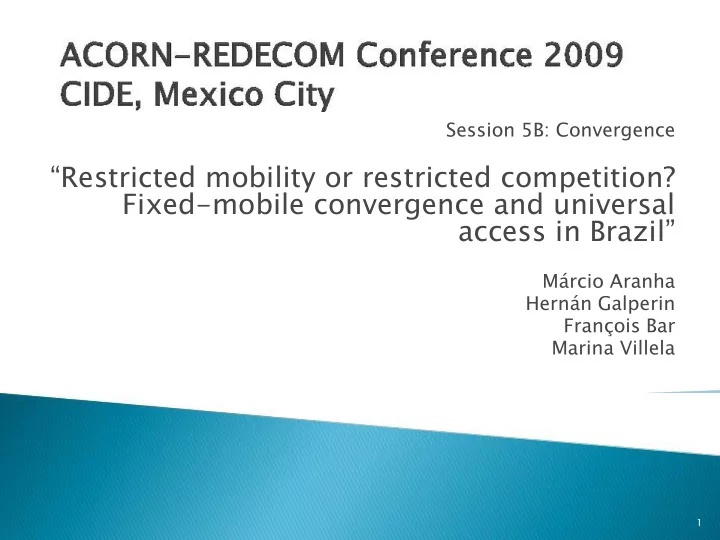

Session 5B: Convergence “Restricted mobility or restricted competition? Fixed-mobile convergence and universal access in Brazil” Márcio Aranha Hernán Galperin François Bar Marina Villela 1
Region gion 1 1 Local Region gion 2 2 Embratel Livre Region gion 3 3 Vésper Portátil 2
180 160 150.6 140 120.9 120 99.9 100 86.2 SMP 80 65.6 STFC 60 46.3 42 40 42.3 42.3 41.1 42.1 42 42.1 20 34.9 0 2002 2003 2004 2005 2006 2007 2008 3
Liv ivre re 1.8 1.8 1.6 1.4 1.4 1.2 1 0.94 0.8 0.712 Livre 0.6 0.4 0.252 0.2 0.12 0.003 0 2002 2003 2004 2005 2006 2007 2008 4
Em Embrat ratel el Liv ivre re dis istribution ribution (S (Septe ptember, mber, 2008) 8) 31569 Users in cities > 150,000 6303 159 inhabitants Users in cities between 100,000 and 150,000 inhabitants Users in cities < 100,000 inhabitans 1662957 Users of Embratel Livre wired 5
Vé Vésper sper Por ortá táti til / Embratel Livre Loc ocal Telec ecom omun unicaç cações ões Business Served areas, Handset economies Underserved model subscriptionless of scale, low-cost areas, small-scale service, market niche deployment, operator, local affordable plans entrepreneurship Spectrum 1975-1990 MHz (RBS to terminal) 1835-1838 MHz (RBS to 1895-1910 MHz (Terminal to terminal) RBS) 1740 MHz (Terminal to RBS) Technology CDMA GSM Service license: STFC Service license: STFC License WLL radiofrequency licenses Secondary radiofrequency licenses All codes of regions 1, 2 and 3 Codes 85 to 88 (Region 1) Area 1.8 million (Dec, 2008) 2,600 (Dec, 2007) Subscribers 6
Small-scale telecom Local Innovative business operator entrepreneurship model Area or little interest Low-cost to traditional technologies operators 7
So far, the conjunction of an enabling regulatory environment with innovative business models, wireless technologies applied to STFC networks, along with user satisfaction with mobility restrictions, resulted in crescent deployment of FWA and GSM systems as fixed telephone services in Brazil. 8
This trend is under peril due to the lack of a new regulatory approach designed to: ◦ preserve the fragile situation of a fixed phone company using cellular frequencies on a secondary basis; ◦ assure operators the ability to apply restricted mobility in their fixed phone networks. 9
The cases described show that different strategies were applied for different purposes and conditions. ◦ On high-density areas, in which Vésper Portátil and Embratel Livre provide STFC, FWA/WLL application has proved to be an important tool to reverse STFC deployment stagnation. In this case, FWA/WLL functions as a successful business model oriented towards low-income, senior population satisfied with subscriptionless low-cost telephony services restricted to neighborhood mobility. Previously referred limits on mobility experienced in the Embratel’s case show that a service unified license would facilitate the implementation of such approach. ◦ Local case, in turn, proved to be an important initiative to increase universal access in low-income areas providing low-price services through two simple service plans as a small-scale operator present in the local community life. 10
Recommend
More recommend